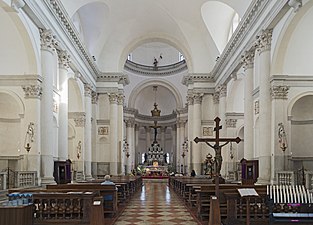Il Redentore
| Chiesa del Santissimo Redentore Church of the Most Holy Redeemer | |
|---|---|
Renaissance | |
| Groundbreaking | 1577 |
| Completed | 1592 |
| Specifications | |
| Length | 75 metres (246 ft) |
| Width | 30 metres (98 ft) |
| Nave width | 20 metres (66 ft) |
The Chiesa del Santissimo Redentore (English: Church of the Most Holy Redeemer), commonly known as Il Redentore, is a 16th-century
It was designed by Italian Renaissance architect
History
Il Redentore was built as a
The cornerstone was laid by the Patriarch of Venice Giovanni Trevisan on 3 May 1577 and the building was consecrated in 1592.[4] At the urgent solicitations of Pope Gregory XIII, after consecration the church was placed in charge of the Order of Friars Minor Capuchin.[5] A small number of Friars reside in the monastery attached to the church.
Every year the
The church was the scene of vandalism on 15–16 May 2022 after a group of three people – who were later arrested after being identified on CCTV footage – painted a three meter wide portion of the front facade of the church with pink paint as well as an equation of some sorts on top of the pink. A local tried removing the paint using water, but was unsuccessful in their efforts and only allowed the paint to permeate the stone it was displayed on. The restoration is now being handled by government art officials.[7]
Exterior
Il Redentore has one of the most prominent sites of any of Palladio's structures, and is considered one of the pinnacles of his career. It is a large, white building with a dome crowned by a statue of the Redeemer. On the façade a central triangular pediment overlies a larger, lower one. This classical feature recalls Palladio's façade for San Francesco della Vigna, where he used an adaptation of a triumphal arch. Palladio is known for applying rigorous geometric proportions to his façades and that of this church is no exception. The overall height is four-fifths that of its overall width whilst the width of the central portion is five-sixths of its height.[3]
It has been suggested that there are some oriental influences in the exterior, particularly the two
Interior
As a pilgrimage church, the building was expected to have a long nave, which was something of a challenge for Palladio with his commitment to classical architecture. The result is a somewhat eclectic building, the white stucco and gray stone interior combines the nave with a domed crossing in spaces that are clearly articulated yet unified. An uninterrupted Corinthian order makes its way around the entire interior.
Art work
Il Redentore contains paintings by
The church was painted by Canaletto a number of times,[9][10] notably in a painting currently held at Woburn Abbey, England.[11]
Gallery
-
Interior view
-
Plan of the church (1783)
-
Longitudinal section (1783)
-
Transversal section (1783)
-
Il Redentore and Canale della Giudecca
See also
- History of early modern period domes
- List of buildings and structures in Venice
- List of churches in Venice
Notes
- PMID 5906745.
- ^ Herbermann, Charles, ed. (1913). . Catholic Encyclopedia. New York: Robert Appleton Company.
- ^ a b Weissmüller, Palladio in Venice, p. 118
- ^ Herbermann, Charles, ed. (1913). . Catholic Encyclopedia. New York: Robert Appleton Company.
- ^ Constant 1993, pp. 122–124
- ^ File:The Night of the Redentore,1995, oil on canvas, 79'x110', Sergio Rossetti Morosini.jpg
- ^ Buckley, Julia (27 May 2022). "Venice tourists swim nude in canals and vandalize church". CNN.
- JSTOR 3592517
- ^ "A View of the Church of the Redentore, Venice". Artnet. Retrieved 28 August 2011.
- ^ "Il Redentore". CH 11441. Bridgeman Art Library. Archived from the original on 30 September 2011. Retrieved 28 August 2011.
- ^ Roberts, Keith, ed. (1965). XII The Church of the Redentore from the Canal of the Giudecca. Vol. 3. Knowledge Publications. p. 8. Retrieved 28 August 2011.
{{cite book}}:|work=ignored (help)
References
- Constant, Caroline (1993), Palladio Guide, New York: Princeton Architectural Press, ISBN 1-878271-85-7
- Weissmüller, Alberto (2007), Palladio in Venice, Grafiche Vianello Srl, ISBN 978-88-7200-174-5
External links
| Preceded by Punta della Dogana |
Venice landmarks Il Redentore |
Succeeded by Rialto Bridge |






